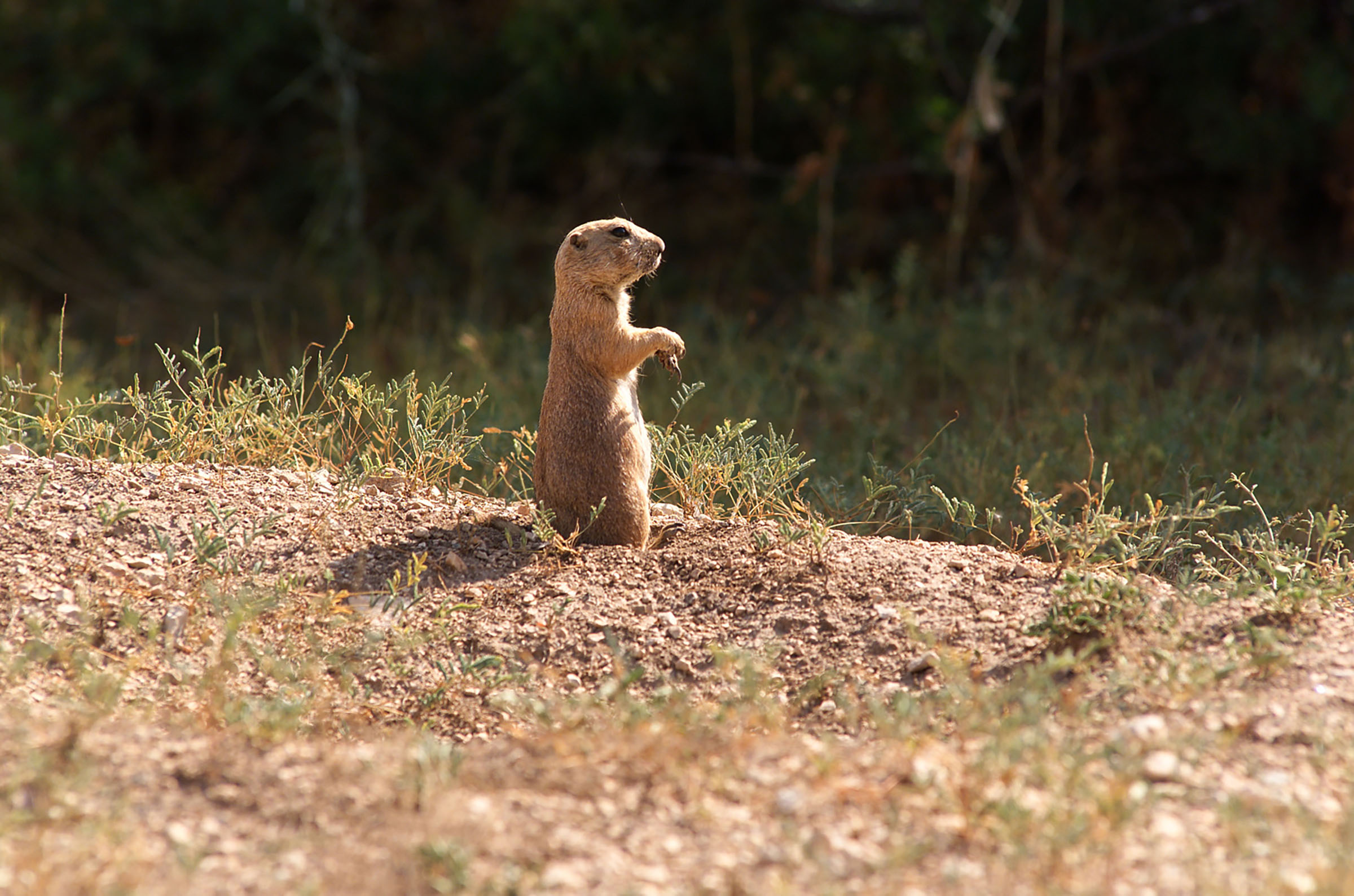
Prairie dogs have found a sanctuary at Prairie Dog Town since 1935. Photo by Stan A. Williams.
Call it a prairie dog potluck, because everyone who visits Lubbock’s Prairie Dog Town comes with provisions. They show up with carrot sticks and celery, whole loaves of white bread, fist-sized chunks of watermelon, bags of Cheetos, sliced cantaloupe, freeze-dried peas, and all manner of other snacks. The hundreds of black-tailed prairie dogs who call this 7-acre community home take it all gladly, and sometimes greedily. They’re clearly well-fed: On a recent Saturday in July, more than a few of the town’s visitors commented on their shapely figures. No matter—if the dogs took offense, they didn’t let on. They just kept on eating.
The critters earn their treats by being photogenic and fun to watch. Adults weigh in at about 2 pounds; they’re roughly the size of a cottontail rabbit. It’s hard to know just how many residents live in Prairie Dog Town, but on the day I visited, dozens of dogs scurried back and forth between a network of holes in the sandy soil, sometimes assuming an upright pose to scan for predators or have a quick chat with a neighbor. A steady stream of people filed into the area as morning turned to afternoon: a young couple holding hands and pointing out their favorite dogs, some high school kids gawking and taking videos on their phones, a road-weary family who needed to stretch their legs.
The Chapos were traveling from Virginia to visit family nearby. The eldest child, 15-year-old Antonio, lobbed pieces of bread to the prairie dogs and watched eagerly to see which one would end up with the scraps. It was like that kids’ game Jackpot, where you throw a football in the air and watch the other players jostle and elbow to catch it. Except in this case, the football is a piece of bread, and the jostling players are actually a scrum of slightly overweight rodents.
Antonio’s sister, 11-year-old Eva, tended to distribute bread to the dogs that scurried closest to the low wall separating us from them. She also fed individuals that she determined were a) very cute or b) very hungry. After spending an afternoon on the frontlines of the prairie dog cafeteria, Eva now considers the animals to be part and parcel of Texas. “I’ve done two things since I’ve been in Texas,” she said. “I’ve been to Buc-ee’s and I’ve fed the prairie dogs.”
Prairie Dog Town is situated in Mackenzie Park, on the city’s north side. From the entrance, a narrow road leads visitors to a parking lot and pavilion. The town is shaped like a tortilla chip and surrounded by a waist-high cinder block wall. Inside the wall, and underground, the dogs have dug an intricate system of tunnels to connect the hundreds of holes that pock the town’s landscape. The tunnel system includes burrows for bedrooms, nurseries, and even toilets. It’s an impressive feat of engineering. They’ve had plenty of time to practice their craft, after all: Prairie dogs have been tunneling through North America for between 2.6 million and 3.6 million years. Even without the free lunch, they’d do just fine.
It wasn’t so long ago that black-tailed prairie dogs ruled the Southern Plains, a region that includes Lubbock and Amarillo. Their vast underground cities spread across the continent; they numbered close to 400 million. But when Anglo settlers showed up in the late 19th century, the dogs were displaced on a massive scale. Farmers and ranchers viewed them as crop-pilfering pests, freeloaders squatting on tillable acreage—thus the dogs were run out of their own towns. They now occupy less than 1% of their native range, which once stretched from Saskatchewan, Canada, to Chihuahua, Mexico.
Lubbock’s Prairie Dog Town was created in 1935 by cotton buyer K. N. Clapp, who wanted to give the critters a safe haven. It was the first protected prairie dog community of its kind. The town didn’t change much until 2005, when the pavilion, interpretive signage, and sidewalks were added courtesy Premier Golf, a 36-hole course that abuts the town. A historical marker has been placed at the site.
Black-tailed prairie dogs are a “keystone species” of the prairie, meaning many other species in the ecosystem depend on them for their survival, according to Rick Gilliland, a wildlife biologist for Texas Wildlife Service. “They are important prey for raptor species: hawks, eagles, things like that,” he said.
Speaking of predators, as I watched the dogs cavort through their town, a Mississippi kite was wheeling in the cloudless sky above—no doubt it was scheming to snatch up an unsuspecting dog and spirit it away, traumatizing several young children in the process. But prairie dogs have virtues beyond merely being tasty; their abandoned holes provide a habitat for other fascinating critters. One of them is the burrowing owl, a small bird with bright yellow eyes that sometimes nests in prairie dog holes; another is the black-footed ferret, a nocturnal predator and one of the state’s rarest mammals.
It’s not unusual to see locals visiting the place. Justin Calderon, who grew up in nearby Ralls before moving to San Antonio, came back to see the prairie dogs with a friend in July. “It’s like a time capsule, a reminder of what this place used to be like thousands of years ago,” he said while tossing freeze-dried snap peas to the dogs crowding the front wall. “Growing up in town, you see the holes everywhere. If you think about it, you realize that it goes back generations.”
Accompanying Calderon was Allison Seamans, who was visiting the town for the first time. “I think it’s unique. And I like that it’s wide open, so that you can just come and visit them,” she said. Describing their drive here, she said they discussed snack options for the prairie dogs. They pulled into a gas station near the park and asked the cashier what prairie dogs like to eat. She gave the pair a hard look, as if to question their sanity, Seamans said. They saw the peas inside the store, grabbed them, and hurried out. (It turns out that prairie dogs like dried snap peas just fine, and it’s probably better for them than Wonder bread.)
For all their cuteness and ecological benefits, prairie dogs are divisive creatures in Lubbock County. Agricultural producers haven’t warmed to them much since the frontier days. And being rodents, prairie dogs have the capacity to reproduce exponentially, Gilliland said. Overpopulated towns have the habit of spilling outside of their boundaries into developed areas where the dogs may be unwanted, peeving human residents. Still, Lubbock’s unofficial mascot is Prairie Dog Pete, a real-life prairie dog living in Mackenzie Park. Similar to the better-known Punxsutawney Phil in Pennsylvania, Pete emerges from his hole each February to determine if Texans will experience an early spring or a lingering winter. Every now and then he’s right.
As I prepared to bid adieu to the Prairie Dog Town that day, I witnessed a heartwarming scene. A pair of prairie dogs, who I figured for a mother and her pup, sat contentedly on the sand whilst sharing a Cheeto. It wasn’t a regular Cheeto, either—it was one of those big, puffed-up ones, and it looked impossibly big in their four tiny paws as they gnawed on either end of it. Ah, I thought, a mother and her offspring. Just as nature intended. They were still working on the corn puff as I loaded into my truck and pulled around the drive to head back home, away from their town and back to my own.








